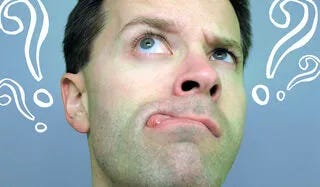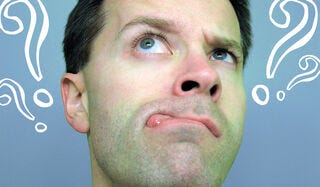Heuristics and Biases, Related But Not the Same
Heuristics and biases are often treated as synonymous when they aren’t.
A previous version of this post was published on Psychology Today.
In my last two entries, I explored biases and heuristics. I wrote about them separately because they each have a unique role in shaping human decision making. But when I was writing about heuristics, I realized how often people treat biases and heuristics as though they are interchangeable1. This is understandable—heuristics and biases frequently overlap in decision making, and it can be tricky to pull them apart.
The truth, though, is that biases and heuristics are not synonymous. It may be difficult to tease them apart in some situations, but by treating them as if they were the same things, we miss nuances that are important for understanding human decision making.
Let’s take a closer look at how biases and heuristics differ and how they work together when we make everyday decisions.
Biases vs. Heuristics
Biases, regardless of whether they are hardwired into us due to evolution, learned through socialization or direct experience or a function of genetically influenced traits, represent predispositions to favor one conclusion over others. These leanings influence our judgments, often causing us to prioritize certain information or conclusions. In this way, biases shape what we perceive as important and can influence how we ultimately choose among different options. Therefore, biases can be thought of as the preferences, priorities, or inclinations that influence our decision-making.
Heuristics are mental shortcuts that allow us to make decisions more quickly, frugally, and/or accurately than than if we tried to consider all possible information. They’re derived from experience, formal learning, or observation and are refined over time as we encounter new information and situations. Heuristics represent strategies we use to navigate complex environments efficiently—they help us filter, prioritize, and attend to the information we need without being overwhelmed by the sheer volume of available data.
Where biases act as our leanings—telling us what to favor—heuristics are the methods or processes we use to make decisions. For example, a bias might predispose us to prefer one brand over another, while a heuristic helps us recognize the logo of that brand quickly, reducing decision-making effort. Biases influence the direction in which we lean, while heuristics shape the path we take to make a decision.
By treating biases and heuristics as separate but related elements, we can better understand how they each play a role in our decision making and how they interact to shape our choices.
Biases and Heuristics in Action: The Great Deodorant Crisis
Let’s dissect a simple decision. You’ve just taken a shower, dried off, and gotten dressed when you notice you’re running low on deodorant. That’s not an ideal situation!
If you’re like many people, you might sit at your computer, pull up your favorite online store, and re-order a three-pack of the deodorant you always use2. You probably didn’t spend hours researching the best deodorant—because you already have a preferred brand. This preference likely reflects a bias toward maintaining the status quo. You also use a heuristic to identify the product quickly (usually by sight) before adding it to your cart. In this instance, your bias influenced your preference for your current deodorant, and your heuristic helped you find it efficiently. Crisis averted!
But let’s change the scenario up a little bit. Imagine you sit down to buy your favorite deodorant online, only to discover it’s out of stock. Suddenly, the decision isn’t as straightforward, and this is where our biases and heuristics come into play in a more nuanced way.
Let’s start by considering a scenario where you have a strong bias toward maintaining the status quo—you really want to stick with the deodorant you’ve been using. This bias motivates you to find that specific product, even if it's unavailable at your usual store. You decide to look elsewhere, perhaps checking other online vendors or even heading to a physical store. Here, deciding where to look next is guided by the availability heuristic: you are more likely to check an alternative store that readily comes to mind. This mental shortcut makes the process efficient, saving you from unnecessary deliberation and helping you maintain consistency with minimal effort.
Let’s start by taking the scenario in which you have a strong bias toward maintaining the status quo and ordering the deodorant you have been using. In that case, you will likely be motivated to make a purchasing decision consistent with your strong bias (i.e., look to purchase it from a different vendor, maintaining the status quo with your deodorant). Thus, in this scenario, you decide to look elsewhere.
Of course, where to look is another decision. You can either choose to conduct an extensive review of sites where your product is available, or you can do what most people would do: check one of the other online stores where you tend to shop. At this step, the availability heuristic is likely to guide your decision, causing you to navigate to an alternative site that quickly comes to mind.
However, let’s say you don’t have a strong preference toward the brand and type of deodorant you’ve been using. In this instance, the Great Deodorant Crisis may be much less of a crisis because you’re less inclined to stay with the status quo, instead opting to see what else is available at your regular online vendor3. The weaker your bias toward the status quo, the more likely you are to choose this option.
This choice, too, involves another decision. In this case, you employ heuristics to help you select an alternative product that meets your criteria. You might decide to look for a different deodorant within the same brand or a similar type from another brand. To narrow down your options, you may use additional heuristics, such as looking at product ratings or comparing prices, until you find something that is good enough to meet your needs.
You’re unlikely to conduct an exhaustive review of every available option. Instead, you might rely on a satisficing heuristic—choosing the first product that seems good enough—or a similarity heuristic—selecting the product that resembles your current deodorant the most. These heuristics help you make the decision efficiently without unnecessary effort.
In resolving the Great Deodorant Crisis, the strength of your bias shapes your initial approach—whether you decide to stick with the same product or consider alternatives. Meanwhile, heuristics play a crucial role in helping you quickly filter the available information, making the overall decision-making process faster and more manageable.
Biases and Heuristics in Everyday Decisions
While the deodorant example may seem trivial, it illustrates how biases and heuristics shape many of the decisions we make every day. Whether it's choosing a deodorant or making more consequential choices—like deciding who to hire, how to invest in the stock market, or when to seek medical care—biases and heuristics guide our thought processes. In these more important decisions, we may have multiple biases influencing us (e.g., a preference for job applicants who share similar traits or skills) and often rely on a combination of heuristics. For instance, hiring decisions might use a fast-and-frugal tree to determine which candidates are acceptable, followed by a take-the-best heuristic to make the final selection4.
The issue is often whether your biases and heuristics are aiding or inhibiting the ecological rationality of your decision, and that will vary from situation to situation. Ultimately, biases help direct our preferences, and heuristics guide how we act on those preferences. Understanding this interaction can help you make better, more context-aware decisions. Next time you’re faced with a choice, take a moment to consider: Are your biases steering you in a productive direction, and are the heuristics you’re using helping you to achieve your decision goals? The more you understand these mental shortcuts, the better you can put them to good use.
Footnotes
Gigerenzer and Brighton (2009) chronicled how they became entangled.
Your biases may also have influenced the online vendor you chose to buy from, which was a second decision we could dissect, but I want to keep the example simple here.
Especially since you are already there.
I’m not implying that all hiring possesses these biases or relies on these heuristics. Instead, I’m simply illustrating examples of the biases and heuristics that may influence the hiring of a job applicant.




